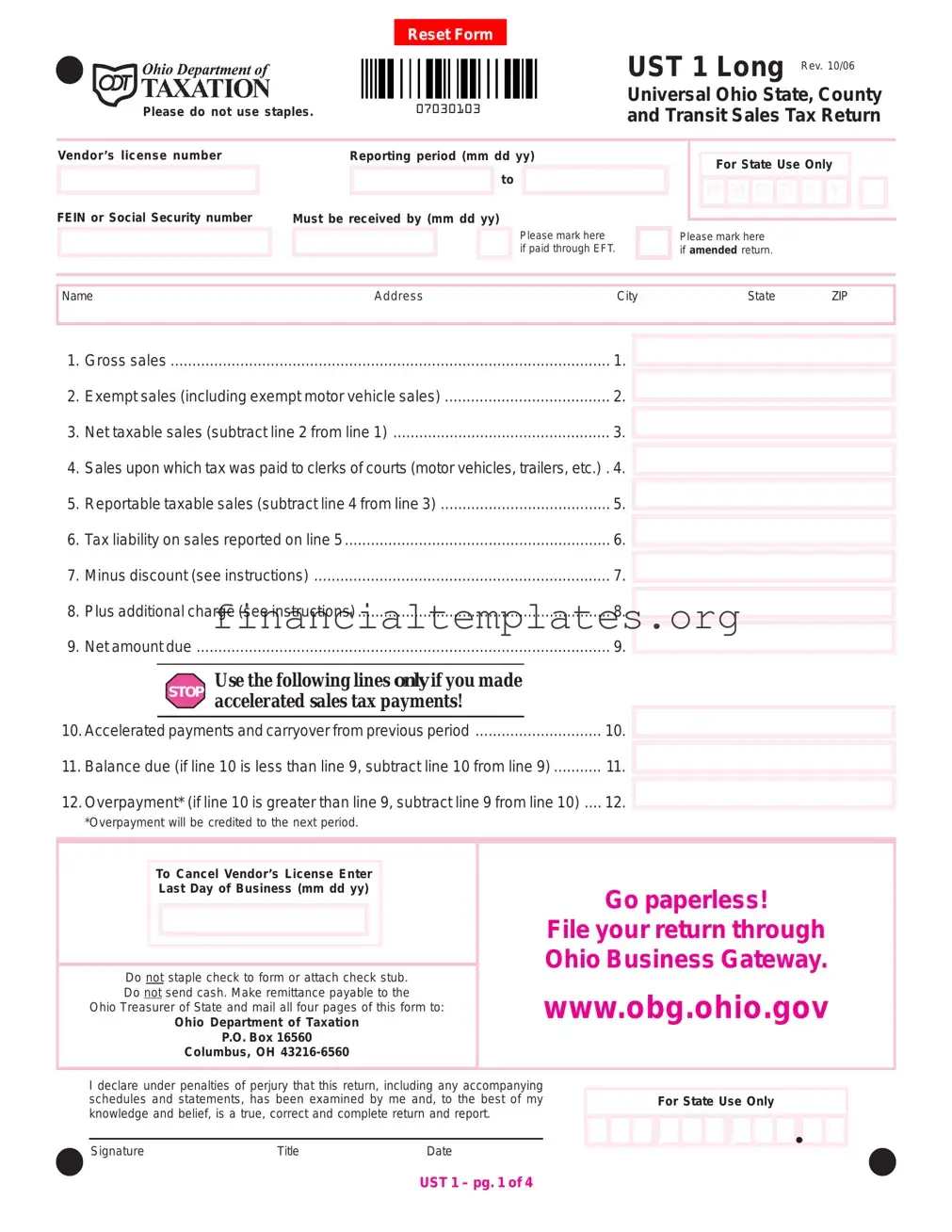The Form 1040 for individual income tax returns shares similarities with the Ohio Sales Tax UST 1 form by necessitating the disclosure of financial figures to calculate tax responsibility. Both require taxpayers to report income, or in the case of UST 1, gross sales, and allow for deductions or exemptions to arrive at a net taxable figure. Adjustments in both forms can lead to a determination of either tax due to the government or an overpayment, which can be credited to future obligations.
State-specific sales and use tax forms from states other than Ohio, such as California's Sales and Use Tax Return, have analogous reporting requirements, aiming to calculate tax liability from sales. They collect details on gross sales, exemptions, and calculate net tax due. Much like the Ohio UST 1 form, these documents often have sections dedicated to specific types of transactions, adjustments, and detail county or local tax rates where applicable.
The Employer's Quarterly Federal Tax Return, known as Form 941, parallels the Ohio Sales Tax UST 1 form through its structured approach to reconciling amounts due over a set period. Form 941 requires employers to report wages paid, taxes collected from employees, and assess the employer's portion of Social Security and Medicare taxes, similarly detailing calculations that lead to either a due amount or overpayment.
Business Tax Returns, like the Federal Corporate Income Tax Return (Form 1120), share commonality with the Ohio Sales Tax UST 1 form through their need to categorize and report various types of income, deductions, and tax liability. Both forms serve as a means for entities to reconcile their taxable activities with the governing tax authorities, ensuring the right amount of tax is assessed and collected.
The General Excise Tax (GET) form used in states like Hawaii is similar to Ohio’s UST 1 in its purpose of collecting tax on business activities. However, GET notably encompasses a broader range of transactions beyond sales, including services and leasing. Both forms require the reporting of gross amounts followed by allowable subtractions to arrive at a net taxable base and respective tax due.
Sales Tax Exemption Certificates resemble the exempt sales reporting section of the UST 1 form. While not tax returns themselves, these certificates are crucial for businesses to document why certain sales are not subject to tax, aligning with the UST 1's requirement to separately report exempt sales, including specific exemptions such as motor vehicle sales.
VAT (Value-Added Tax) Returns used in many countries outside the United States share a conceptual similarity with Ohio’s UST 1 form in capturing the value added at each stage of production or distribution. Both types of documents aim at taxing the end consumer sale, requiring detailed reporting of sales and purchases to calculate the tax owed or refund due.
The Streamlined Sales and Use Tax Agreement (SSUTA) Exemption Certificate, like the Ohio UST 1 form, is used in the context of sales taxation but specifically for documenting exemptions under the streamlined sales tax project in participating states. This similarity is found in the management and reporting of exempt transactions, ensuring compliance with tax laws across state lines.
The Monthly Sales and Use Tax Return forms that many small businesses must file, similar to the Ohio UST 1, capture taxable sales on a more frequent basis. These forms maintain the theme of reporting gross sales, deductions for exempt sales, and calculating the amount of tax due or overpaid within the designated period, illustrating both the regularity and necessity of such tax reporting.
Lastly, the Commercial Importer’s Declaration forms, which account for the value and duty of imported goods, resemble the transactional reporting aspect of Ohio’s UST 1 form. Both require detailed itemization and valuation of activities (imports for the former, sales for the latter) that culminate in a tax or duty liability, showcasing the global breadth of tax and duty reporting mechanisms.


 M
M  D
D  D
D  Y
Y  Y
Y 



